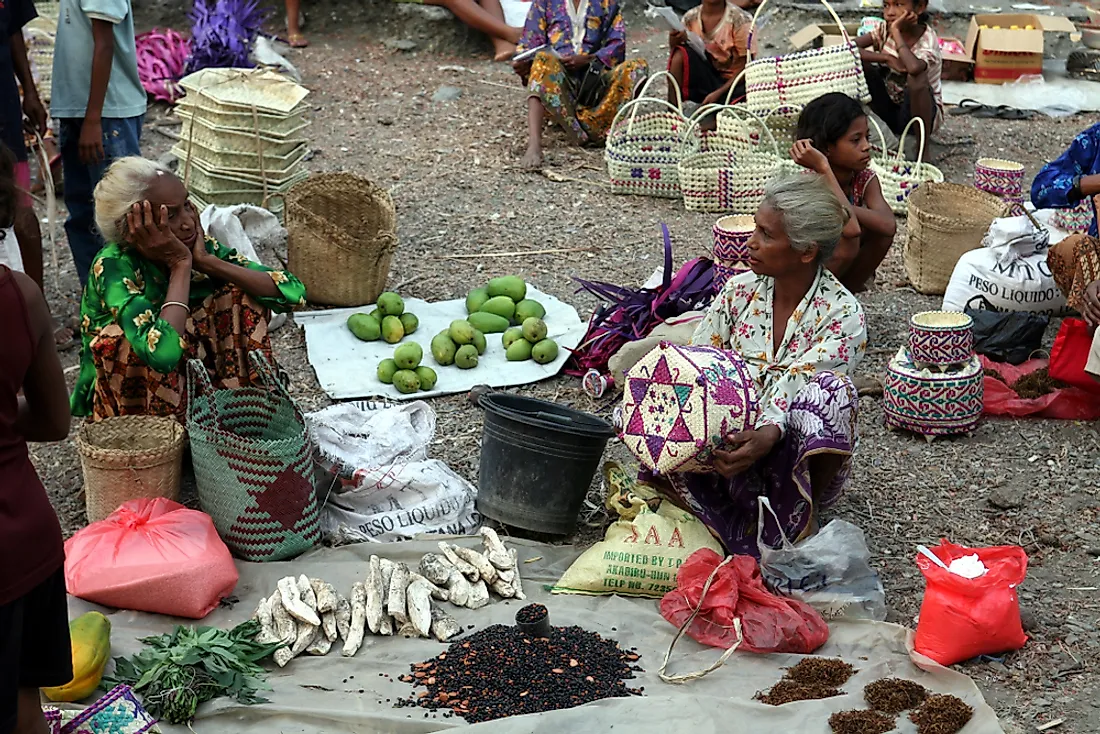The Culture Of East Timor

The small, Southeast island nation of East Timor (Timor-Leste) comprises the Timor island’s eastern half and also includes some nearby islands. The country hosts a population of around 1,321,929 inhabitants. It has great ethnic diversity. The native population consists of many distinct ethnic groups of mixed Melanesian/Papuan and Austronesian descent. The country also hosts people of mixed Portuguese and East Timorese origin, a result of interracial marriage during Portuguese colonial rule. A small Chinese community also resides in the country. Thus, the country’s culture is a blend of the distinct cultures of its diverse ethnic groups. Christianity is the dominant religion in East Timor, a legacy of the colonial rule. 97.6% of the population practice Roman Catholic Christianity.
5. East Timorese Cuisine
The cuisine of East Timor is heavily influenced by the cuisines of Southeast Asian nations and Portugal (the country was a Portuguese colony in the past). Rice, cassava, taro, and maize are the staples of the diet. Cowpeas, onions, cabbage, spinach, etc., are also consumed. Most homes in the country raise their own animals for milk and meat. Chicken and meat of goats and pigs are widely consumed. Some examples of East Timorese dishes are tapai (a fermented rice dish), caril (chicken curry with coconut paste and capsicum), Feijoada (a pork dish), etc. Desserts include Portuguese tart and Bibinka (a layered coconut cake).
Due to the unpredictable nature of precipitation and the varying climate patterns in the country, droughts are common, especially during the dry season between November and February. During such stressed times, the people subsist on akar which is the powder produced by beating the bark of the palm tree.
Coffee is a major cash crop of East Timor and is one of the country’s biggest export products. Coffee is also consumed domestically.
4. Literature and Arts
Written literature in East Timor developed only recently. The literary scene in the country began during the Portuguese colonial reign. Literature flourished during the people’s struggle for independence from foreign rule. Xanana Gusmão, a former Prime Minister of East Timor, is the most celebrated writer in the country. He was a leader of the natives’ resistance to colonial rule and wrote two books on the fight of the people for independence. He also wrote many books on the culture and values of the people of the country.
The East Timorese craftsmen are very creative with their unique craftsmanship. Traditional hand woven fabrics called tais are sought after. These fabrics are produced in vibrant tribal designs, colors, and patterns. Basketry skills of the East Timorese are also widely appreciated. Other crafts in the country that attract the attention of tourists include embroidered bags, pottery, jewelry, musical instruments, dolls, and paintings. Roadside stalls and traditional markets sell such handicrafts.
3. Performance Arts in East Timor
The music of the country is influenced by the Portuguese and Indonesian music. The guitar is an integral part of the country’s music while indigenous string instruments are also used. The likurai dance is a folk dance that is performed by women in the country. Traditionally, it was performed to the beat of drums to welcome men returning after a war, often carrying the enemy heads in processions through the village. During the colonial rule and Indonesian rule in the country, East Timorese music was associated with patriotism and the struggle for independence. In more recent times, foreign styles of music and dance like hip-hop, reggae, rock and roll, etc., have captured the attention of the country’s younger generations.
2. Sports in East Timor
Although the people of East Timor play a number of traditional games and international sports, the athletic activities of the country’s sportsmen are limited at the professional level. The widespread poverty existing in the country is responsible for the low levels of success of the country’s sportsmen in international competitions. They have limited access to sophisticated training equipment, and facilities to prepare themselves for such competitions. The Timorese athletes have taken part in the Olympic Games, the 2003 Southeast Asian Games, etc.
1. Life in the East Timorese Society
Timor Leste had a tumultuous past. The people of the country have suffered centuries of Portuguese colonial rule and then invasions by Indonesia. The country’s economy, although recovering now, still has great scope for improvement. Poverty and unemployment are widespread. Despite the hardships, the people haven’t forgotten to smile. They shake hands when meeting strangers and flash bright smiles at them. The East Timorese people are known for their friendly nature. Humor is well-received by these people. Humour has helped them cope with their problematic past.
The people of the country are highly religious. Along with Christianity, they also continue to practice their animistic indigenous rituals.
The society in the country is patriarchal in nature with women’s roles usually being confined to childcare and household chores. Women in the country suffer from domestic violence. Rape cases are also high. Early and forced marriages are common. Teenage pregnancies are a result of it. Men dominate the society and their decision is regarded as final. East Timorese households are usually extended in nature with patrilocal residence.











